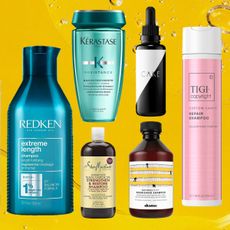If you've ever felt a hot gust of exhaust in your face as a bus passed by and thought, That can't be good, you're right. We know that air pollution is bad for our lungs, but now researchers are learning just how terrible it is for our skin, too. "It increases inflammation and irritation, which accelerates aging in the skin and leaves it more vulnerable to damage," says integrative medicine pioneer Dr. Andrew Weil. "And we're dealing with a new degree of pollution we haven't had to deal with before."
It's not all gloom and doom, though. There are steps you can take now to keep air pollution from wreaking havoc on your complexion. First, it helps to know your enemy. There are two main types of air pollution: particulate matter (PM) and ground-level ozone. PM comprises tiny bits of soot and liquid droplets of acids and chemicals suspended in the air, while ground-level ozone is a noxious gas created by toxic emissions reacting in the presence of sunlight. Both come from vehicle exhaust, industrial emissions, and the by-products of electricity production.
"Think of it as inflammation soup," says Washington, D.C., dermatologist Dr. Elizabeth Tanzi—a soup that leads to premature lines, aggravated acne, spots, and increased sensitivity. "The effects are cumulative," she adds. A 2010 German study found that women who spent years living near high-traffic roads had 20 percent more hyperpigmentation on their foreheads and cheeks than those living in more rural areas.
And skin-damaging pollution knows no borders: Nearly half of the people in the United States (147.6 million) live in counties with unhealthy levels of either ozone or particle pollution. Although large cities can be hotbeds, the countryside isn't always better, says Janice Nolen, the American Lung Association's assistant vice president for national policy. Trendy wood-burning stoves, for instance, are big-time air polluters.
As for ozone pollution, Los Angeles is number one for dangerous ozone, but some of the worst levels on the East Coast are actually hanging north of New York City, over Connecticut, a state known for its pastoral landscape. (To see how your ZIP code ranks in air pollution levels, visit stateoftheair.org.)
Clean Like You Mean It
Yes, you have to get all that gunk off your skin—but a quick wash with your fingers and soap may not do it. Truly insidious pollution is made up of particles that are 20 times smaller than the diameter of a skin pore, says Bellevue, Washington, dermatologist Dr. Lauri M. Tadlock. "The size of particulate matter is linked to the speed and depth at which pollutants penetrate the layers of skin," she says. "Anything under PM 10 [particles measuring 10 micrometers or less] can be damaging, and many areas around the world are facing dangerous levels of pollutants as small as PM 2.5."
Stay In The Know
Marie Claire email subscribers get intel on fashion and beauty trends, hot-off-the-press celebrity news, and more. Sign up here.
Enter sonic facial brushes. In a clinical study, Clarisonic found that its cleansing device removed 35.8 times more pollutants than manual cleansing. "The sonic brush is my favorite way of removing PM and keeping it from causing damage to the skin," says Tanzi.
Replenish Antioxidants
You already knowthat ground-level ozone is problematic, but things get worse on sunny days. When combined with UV light, it depletes your skin's naturally occurring protective antioxidants three times faster than ozone alone, making you more susceptible to skin damage.
To counteract this cascade of complexion woes, Giuseppe Valacchi, Ph.D., a professor at the University of Ferrara, Italy, recommends loading up on topical antioxidants, particularly vitamin E. Consider applying SkinCeuticals C E Ferulic Serum before sunscreen in the morning; clinical studies show that it reduces a type of ozone-induced oxidative damage called lipid peroxidation by 51 percent. There's also research indicating that an oral supplement with vitamins C and E can boost the skin's ability to ward off photodamage; Puritan's Pride Vitamins C & E 500 mg/400 IU with Rose Hips ($11, puritan.com) contains the recommended levels.
Respect Your Barrier
"The skin's barrier contains protective bacteria, as well as cells that play a role in our immune system," says New York City dermatologist Dr. Jeannette Graf. When the barrier is disrupted, which can happen if your products cause sensitivity, skin is more vulnerable to pollutants.
Stay protected with an antioxidant serum and broad-spectrum sunscreen in the morning and a retinol serum followed by a moisturizer at night. Try Origins Mega-Mushroom Skin Relief Soothing Face Cream, with ingredients from traditional Chinese medicine that soothe and strengthen sensitive skin.
Your cleanser matters, too—it should clean deeply but without harsh ingredients that throw off pH levels and compromise your barrier. Pair your sonic device with a fragrance-free wash. "And don't go crazy with exfoliators," adds Tanzi.
If your skin is pink or irritated, that could mean it has lost its protective ability. So use scrubs and peels sparingly: You may not be able to avoid air pollution completely, but there's no reason to open the door and invite it in.
It's the dirt you can't see—20 times smaller than the diameter of a pore—that really harms skin.
Living in a high-traffic area, like Bangkok, has been linked to skin damage.
Agents of Shield
1. Dr. Andrew Weil for Origins Mega-Mushroom Skin Relief Soothing Face Cream, $63; beauty.com.
2. Garnier Skin Renew Daily Moisture Lotion SPF 28, $13; walgreens.com.
3. SkinCeuticals C E Ferulic Serum, $157; dermstore.com.
4. Clarisonic Sonic Radiance Aria Cleansing Device, $199, sephora.com.
Related:
What's The Most Wanted In The World Of Online Beauty
Plump It Up: All About Lip Jobs
Image via Getty Images
-
 Bitten Lips Took Center Stage at Dior Fall 2024 Show
Bitten Lips Took Center Stage at Dior Fall 2024 ShowModels at the Dior Fall 2024 show paired bitten lips with bare skin, a beauty trend that will take precedence this season.
By Deena Campbell Published
-
 30 Spring Items That Solve My Expensive-Taste-on-a-Humble-Budget Dilemma
30 Spring Items That Solve My Expensive-Taste-on-a-Humble-Budget DilemmaSee every under-$300 spring item on my wish list.
By Natalie Gray Herder Published
-
 Your Makeup Won't Budge With These Setting Sprays
Your Makeup Won't Budge With These Setting SpraysPrepare for 12-hour wear.
By Sophia Vilensky Published
-
 The 32 Best Hair Growth Shampoos of 2024, According to Experts
The 32 Best Hair Growth Shampoos of 2024, According to ExpertsRapunzel hair, coming right up.
By Gabrielle Ulubay Published
-
 The 20 Best Hair Masks for Damaged Hair, According to Experts and Editors
The 20 Best Hair Masks for Damaged Hair, According to Experts and EditorsHealthy strands, here we come!
By Gabrielle Ulubay Last updated
-
 How Often You Should Wash Your Hair, According To Experts
How Often You Should Wash Your Hair, According To ExpertsKeep it fresh, my friends.
By Gabrielle Ulubay Published
-
 The 11 Best Magnetic Lashes of 2023
The 11 Best Magnetic Lashes of 2023Go ahead and kiss your messy lash glue goodbye.
By Hana Hong Published
-
 Beauty Advent Calendars Make the Perfect Holiday Gift
Beauty Advent Calendars Make the Perfect Holiday GiftThe gift that keeps on giving.
By Julia Marzovilla Last updated
-
 The 18 Best Natural Hair Products in 2023
The 18 Best Natural Hair Products in 2023Remember: Your curls are your crown.
By Gabrielle Ulubay Published
-
 The 9 Best Hot Rollers for the Curls of Your Dreams
The 9 Best Hot Rollers for the Curls of Your DreamsThis is how we roll.
By Samantha Holender Published
-
 The 12 Best Cream Eyeshadows, According to Makeup Artists
The 12 Best Cream Eyeshadows, According to Makeup ArtistsThe best part? They’re so easy to apply.
By Samantha Holender Published